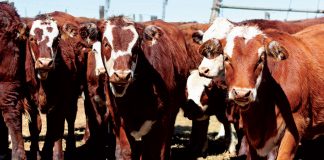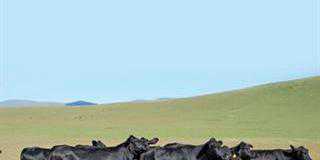“There is this misconception that Brahmans are temperamental and wild, but using the right selection criteria, I have bred a herd that is a pleasure to work with,” says Johan Prinsloo, a Brahman farmer in Thabazimbi, Limpopo.
Together with his wife Isabel, a former maths teacher, he has built up the PRI Brahman Stud of 140 Red Brahman breeding cows and four bulls on the 2 000ha farm Mecklenburg. He is very selective in his breeding process. “At my age, I need to work with calm animals,” Johan says.
“I have managed to breed calm cattle through years of strict selection. After weaning, I cull those with an unsuitable temperament. Before venturing into the world of farming, he was a science teacher for 30 years. “I enjoyed teaching and don’t regret the years I spent in that profession,” he admits.
Johan left teaching in 1998 to farm full-time in Thabazimbi, but he already bought his first Brahman in 1976 from the late Dr Len Minne, a dentist and Brahman breeder from Pietersburg. He kept the animals on his in-laws’ farm in Thabazimbi.
“In 1979, I bought my own land here in Thabazimbi,” he recalls. It was only 172ha, but I sold it to buy the adjoining 500ha in 1986.”
In 2001, he sold the 500ha farm and added his pension to buy the 2 000ha farm Mecklenburg. Here he extended his stud herd and has produced many champions at major shows.
He was awarded the first ever Masters Green Jacket (reserved for the breeder of champions) at the National Brahman Championships in 2008 for having the most champions in the Red Brahman section.
Why the Brahman?
Johan says that since the Brahman arrived in Southern Africa, it has made a name for itself. Because of its longevity, it has the ability to perform and breed under extreme environmental conditions.
He explains that a Brahman is a good choice for a cattleman wanting to produce natural, veld-reared beef. “The Brahman is a heat resistant breed, and perfect to farm with, considering the current climate change threat,” says Johan.
“A Brahman tolerates high temperatures due to its large skin surface area, high density of sweat glands and low respiration rate, all contributing to its high level of heat tolerance. On the hottest day, unlike some breeds that are less tolerant of extreme heat, you can find Brahmans grazing in full sun without any sign of stress. They walk long distances in search of grazing and show a marked resilience to drought.”
Johan says it is no co-incidence that cattle breeders over the years have used Brahman genetics to develop other breeds through cross-breeding. The Brahman contributed to a number of synthetic breeds, including Santa Gertudis (Brahman and Shorthorn), Bradford (Brahman and Hereford), Beefmaster (Brahman, Hereford and Shorthorn) and Brangus (Brahman and Angus).
Johan admits that the Brahman is often criticised, but stresses that under harsh climate conditions, as in Thabazimbi, it is a breed of choice. Many cattlemen in this area run Brahmans or use Brahman bulls for cross-breeding.
“Another reason why Brahmans are sometimes criticised is because they are very intelligent, with a highly developed survival instinct and alert temperament. But they only need to be handled gently and with patience. I often joke with other cattlemen that, because they are so intelligent, you can only farm with Brahmans if you are smarter than they are,” he quips.
Fertility
The cows can continue calving for up to 15 to 18 years of age, sometimes even longer. The bulls can serve cows twice as long as most other breeds. The Brahman’s smooth coat, loose skin, black pigmentation and oil (sebum) discharge makes it capable of resisting disease, ticks and biting flies.
The characteristic sloping rump of a Brahman cow makes her an easy calver. She also has excellent maternal abilities. Brahman cows protect their calves and create the optimal environment for the calf to wean above age. A cow can also limit pre-natal growth for a low calf birth weight and few calving problems. Another advantage of smaller calves is that cows heal, cycle and reconceive more quickly.
Johan selects medium-framed cows as breeding material instead of large-framed cows as the former are more fertile than the latter. His herd’s average intercalving period (ICP) is 403 days in a herd of 140 cows. The breeding season is in October and November. Johan also does artificial insemination with selected semen and selected females and attended a Rothman Livestock Training Service pregnancy diagnosis course in 2010. Calves are weaned at between seven and eight months at an average weight of 233kg for 73 weaners of both sexes.
The PRI Brahmans are run on natural veld and 600ha buffalo grass pasture, the latter for grazing cows with calves before weaning. Brahmans utilise veld grass efficiently with minimum supplementation to produce a marketable carcass. The most important factor for Johan when producing on veld is to manage the grazing.
“You never know what the following season is going to look like and once you have destroyed your grazing, it will take years to recover,” he explains.
Breedplan
Johan obtained a golden merit award from the Brahman Breeders Society for his constant provision of data. Breedplan is an internet-based animal recording and genetic evaluation system that provides a registration and performance analysis service to the livestock industry worldwide. Brahman breeders record specific data pertaining to their animals on Breedplan, enabling them to identify specific traits and estimated breeding values of individual animals and compare these to other animals in their own herds, other herds or the entire Brahman national herd.
“My wife plays a major role in this,” Johan says. “She keeps all the records. The more data we have, the more reliable the estimated breeding values (EBVs) of the animals. If I sell a bull, the buyer will know through its EBVs what to expect from him and his offspring. This helps stud breeders and commercial cattlemen alike to improve the genetic quality of their herds.”
Two PRI bulls and two PRI cows (PRI 03 339 in 2004 and PRI 05 552 in 2008) have been Breedplan Champions at the Pretoria Show since 2004.
A mentor at heart
Since 2008, Johan has been involved in developing emerging cattlemen. In co-operation with Voermol, Pfizer, Obaro and the SA Meat Industry Company (Samic) he trains and advises on bull selection at Ramogatla and Fafung in North West and Holfontein in Limpopo.
He provides selected bulls to emerging cattlemen at a nominal price to get them going on a sound footing, explaining that, with proper support, they have the potential to make a big contribution to beef production. “It is a waste to have land and then not use it productively,” he explains.
“It is my duty as an established farmer to advise emerging cattlemen on the correct way of farming with Brahmans. The lack of quality heifers slows down their progress. At this stage they mainly buy bulls as good heifers are currently expensive due to demand outstripping supply. I look forward to the day when we can supply affordable heifers.”
Contact Johan Prinsloo on 082 805 1852.













